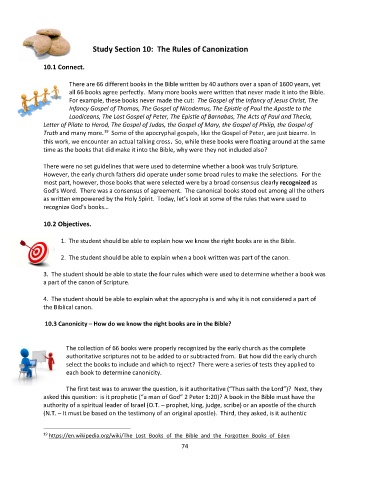Page 75 - Doctrine and History of the Preservation of the Bible Student Textbook
P. 75
Study Section 10: The Rules of Canonization
10.1 Connect.
There are 66 different books in the Bible written by 40 authors over a span of 1600 years, yet
all 66 books agree perfectly. Many more books were written that never made it into the Bible.
For example, these books never made the cut: The Gospel of the Infancy of Jesus Christ, The
Infancy Gospel of Thomas, The Gospel of Nicodemus, The Epistle of Paul the Apostle to the
Laodiceans, The Lost Gospel of Peter, The Epistle of Barnabas, The Acts of Paul and Thecia,
Letter of Pilate to Herod, The Gospel of Judas, the Gospel of Mary, the Gospel of Philip, the Gospel of
Truth and many more. Some of the apocryphal gospels, like the Gospel of Peter, are just bizarre. In
19
this work, we encounter an actual talking cross. So, while these books were floating around at the same
time as the books that did make it into the Bible, why were they not included also?
There were no set guidelines that were used to determine whether a book was truly Scripture.
However, the early church fathers did operate under some broad rules to make the selections. For the
most part, however, those books that were selected were by a broad consensus clearly recognized as
God’s Word. There was a consensus of agreement. The canonical books stood out among all the others
as written empowered by the Holy Spirit. Today, let’s look at some of the rules that were used to
recognize God’s books…
10.2 Objectives.
1. The student should be able to explain how we know the right books are in the Bible.
2. The student should be able to explain when a book written was part of the canon.
3. The student should be able to state the four rules which were used to determine whether a book was
a part of the canon of Scripture.
4. The student should be able to explain what the apocrypha is and why it is not considered a part of
the Biblical canon.
10.3 Canonicity – How do we know the right books are in the Bible?
The collection of 66 books were properly recognized by the early church as the complete
authoritative scriptures not to be added to or subtracted from. But how did the early church
select the books to include and which to reject? There were a series of tests they applied to
each book to determine canonicity.
The first test was to answer the question, is it authoritative (“Thus saith the Lord”)? Next, they
asked this question: is it prophetic (“a man of God” 2 Peter 1:20)? A book in the Bible must have the
authority of a spiritual leader of Israel (O.T. – prophet, king, judge, scribe) or an apostle of the church
(N.T. – It must be based on the testimony of an original apostle). Third, they asked, is it authentic
19 https://en.wikipedia.org/wiki/The_Lost_Books_of_the_Bible_and_the_Forgotten_Books_of_Eden
74

